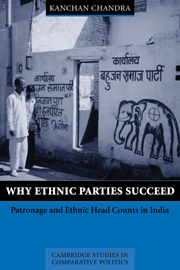Book contents
- Frontmatter
- Dedication
- Contents
- List of Maps, Figures, and Tables
- List of Abbreviations
- A Note on Terminology
- Acknowledgments
- 1 Introduction
- Part I Theory
- 2 Limited Information and Ethnic Categorization
- 3 Patronage-Democracy, Limited Information, and Ethnic Favourit
- 4 Counting Heads: Why Ethnic Parties Succeed in Patronage-Democracies
- 5 Why Parties Have Different Ethnic Head Counts: Party Organization and Elite Incorporation
- Part II Data
- Appendix A Elite Interviews
- Appendix B Ethnographies of Election Campaigns
- Appendix C Content Analysis
- Appendix D Description of Survey Data
- Appendix E Description of the Ecological Inference (EI) Method
- Appendix F Method Used to Estimate Ethnic Voting Patterns
- Bibliography
- Index
- Miscellaneous Endmatter
2 - Limited Information and Ethnic Categorization
from Part I - Theory
Published online by Cambridge University Press: 19 October 2017
- Frontmatter
- Dedication
- Contents
- List of Maps, Figures, and Tables
- List of Abbreviations
- A Note on Terminology
- Acknowledgments
- 1 Introduction
- Part I Theory
- 2 Limited Information and Ethnic Categorization
- 3 Patronage-Democracy, Limited Information, and Ethnic Favourit
- 4 Counting Heads: Why Ethnic Parties Succeed in Patronage-Democracies
- 5 Why Parties Have Different Ethnic Head Counts: Party Organization and Elite Incorporation
- Part II Data
- Appendix A Elite Interviews
- Appendix B Ethnographies of Election Campaigns
- Appendix C Content Analysis
- Appendix D Description of Survey Data
- Appendix E Description of the Ecological Inference (EI) Method
- Appendix F Method Used to Estimate Ethnic Voting Patterns
- Bibliography
- Index
- Miscellaneous Endmatter
Summary
This chapter proposes a connection between limited information and the use of ethnic cues to identify and distinguish between individuals. I argue here that multiple sources of costless data about an individual's ethnic identities are available in most situations, while costless data on an individual's nonethnic identities (e.g., class, profession, income, place of residence, ideological affiliation, educational background) are less frequently available and then typically from fewer sources. Consequently, limited information settings bias observers who are distinguishing between individuals toward schemes of ethnic categorization. Limited information settings, I should emphasize, are sufficient to produce a tendency toward ethnic categorization, according to this argument, but not necessary. A similar tendency may also originate from other sources.
The term “limited information” has come to be used loosely to describe the information environment in all situations of political decision making. I use it here in a more precise sense. By a limited information situation, I mean a decision-making situation in which observers are called upon to identify and distinguish between individuals under severe information constraints. This chapter develops a logic by which this narrowly defined type of limited information setting should bias observers toward schemes of ethnic categorization. I am not concerned here, however, with settings in which individuals are called upon to make different types of decisions, such as distinguishing between groups, ascertaining the links between policy and outcome, identifying the main points of a party platform, and so on. These different types of limited information settings may well require different types of shortcuts.
Section I reviews the literature on the use of ethnic cues as information shortcuts; section II compares the availability of costless data about an individual's ethnic and nonethnic identities; and section III shows how the abundance of costless data on ethnic identities, combined with the scarcity of costless data on nonethnic identities, biases individuals toward schemes of ethnic categorization in limited information settings of the type just defined.
Background
The proposition that many consequential political and economic decisions are made under conditions of limited information is, by now, a familiar one. It has spawned entire fields of research in political science and economics on the use of information shortcuts. The observation that ethnic cues are one among many commonly used types of information shortcuts is also now commonplace.
- Type
- Chapter
- Information
- Why Ethnic Parties SucceedPatronage and Ethnic Head Counts in India, pp. 33 - 46Publisher: Cambridge University PressPrint publication year: 2004

